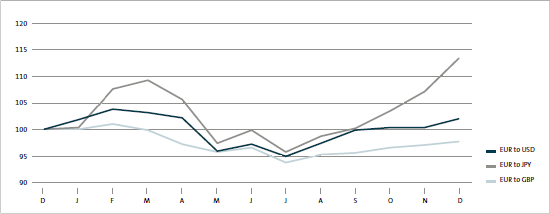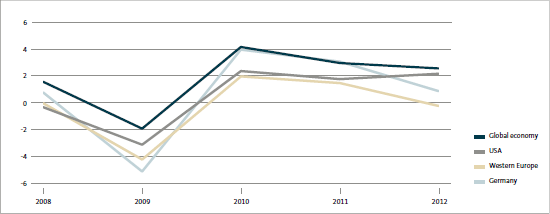Volkswagen Group delivers more than nine million vehicles for the first time
The global economic climate deteriorated significantly in fiscal year 2012. This had a clearly negative impact on parts of the automotive industry. In spite of this, the Volkswagen Group further strengthened its market position: for the first time, the number of vehicles delivered to customers passed the nine million mark. This corresponds to an increase of 12.2% compared with the previous year.
GLOBAL ECONOMY LOSES MOMENTUM
During the reporting period, the global economy registered slower growth than in the previous year. Industrialized nations achieved only low levels of growth as a result of structural obstacles, particularly due to the overburdened budgets of some countries. Emerging market economies continued to perform better than average, but growth rates were still lower. Inflation was moderate despite the expansionary monetary policies of many central banks. The global economy expanded by 2.6% in 2012, down from 3.0% in the previous year.
EXCHANGE RATE MOVEMENTS FROM DECEMBER 2011 TO DECEMBER 2012
Index based on month-end prices: December 31, 2011 = 100
Europe/Remaining markets
In Western Europe, GDP declined by an average of 0.2% compared with a 1.5% rise in the previous year. A few northern European countries joined the southern European EU countries in recording negative growth rates. The overall unemployment rate in Europe rose to 11.8% (previous year: 10.6%), but the figure in Greece, Ireland, Portugal and Spain was much higher than this average. Average GDP growth in Central and Eastern Europe declined to 2.5% (previous year: 4.8%).
The South African economy grew by 2.5% (previous year: 3.5%), but unemployment remained at a high level.
Germany
The weaker global economy and ongoing eurozone crisis meant that Germany’s rate of economic expansion in the year under review also fell short of the prior-year figure. The positive labor market trend continued in 2012 and the ensuing rise in incomes stimulated private consumption and stabilized the economy. Nevertheless, the German economy grew by an average of just 0.9% during the year (previous year: 3.1%).
ECONOMIC GROWTH
Percentage change in GDP
North America
The US economy recorded growth of 2.2% in 2012 compared with 1.8% in the previous year. Unemployment declined only slightly in spite of the continued extremely expansionary monetary policy. The US dollar was volatile against the euro during the period, but ended the year at roughly its starting level. Canada’s GDP rose by 2.0% (previous year: 2.6%) and the Mexican economy expanded by 3.8% (previous year: 3.9%).
South America
GDP growth declined to 1.0% in Brazil (previous year: 2.7%), and dropped sharply in Argentina to 1.7% (previous year: 8.9%). Brazil saw a slight decline in inflation, while Argentina’s inflation rate remained extremely elevated.
Asia-Pacific
Asia’s emerging economies continued to register very positive, albeit less dynamic, growth in 2012. At 7.8%, China’s economic growth was slower than in the previous year (9.3%), but was still above the central government’s target rate of 7.5%. The Indian economy expanded by 5.1% (previous year: 6.9%). The Japanese economy expanded by 2.0% (previous year: –0.5%), as it recovered from the natural disasters in 2011.














